Summary The Central Rift veterinary unit managed to attend to all the reported wildlife cases within the Mara ecosystem
Summary
The Central Rift veterinary unit managed to attend to all the reported wildlife cases within the Mara ecosystem. Some of the veterinary cases included treatment of a wounded elephant in Mara Triangle, rescue of a snared giraffe and snared wildebeests near Governors Camp in Maasai Mara. Bovine tuberculosis disease surveillance and research is still on-going and so far over 50 buffaloes have been captured by darting and sampled. Other activities include collection of lion feaces from the field for a preliminary survey of echinoccocus parasites in lions.
Treatment and rescue of a snared Maasai Giraffe in Maasai Mara NR.
An adult male giraffe was sighted near Main Governors lodge in Maasai Mara with a tight wire snare cutting through the tarso-metatarsal joint of the left front leg. It was found a lone under a tree, it was under intensive pain and not able to move freely with the rest of the herd. Chemical immobilization and restraint The giraffe was captured by darting using 12mgs of etorphine hydrochloride combined with 30mgs of xylazine hydrochloride, darted on the left thigh. The drug took effect after about 10 minutes and the animal was physically roped down.
Examination and treatment
The wire snare was cut off using a wire cutter and the wound treated topically using 10% hydrogen peroxide and tincture of iodine. Blood samples were drawn from the jugular vein to be used for health monitoring and research purposes.
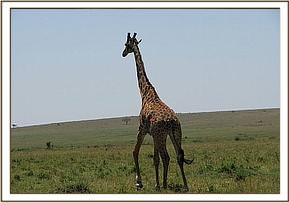
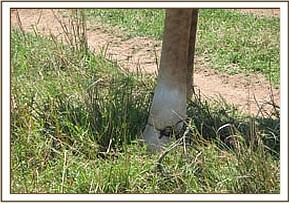
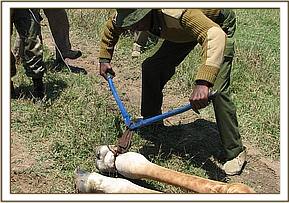
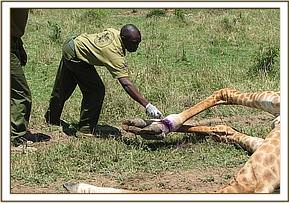

Revival of anaesthesia
After a successful treatment, the animal was revived from anaesthesia using 36mgs of diprenorphine hydrochloride combined with 5mgs of atipamezole hydrochloride administered through the jugular vein. It rose up after about 3 minutes and took off to the wild.
Prognosis
It had good prognosis of recovery after removal of the wire and treatment relieving it from the pain of being cut by the wire.
Removal of a snare and treatment of a wildebeest in Maasai Mara NR.
Just next to where the giraffe was treated, there was an adult male wildebeest with a tight wire snare cutting through the left front leg. It was already weak, limping and preferred lying down most of the time; the wire was relatively long and could be seen from a distant. The wildebeest was captured by darting, the wire was cut off using a wire cutter and the inflicted wound treated using 10% of hydrogen peroxide and a tincture of iodine. After a successful treatment, it was revived from anaesthesia and released back to the wild.
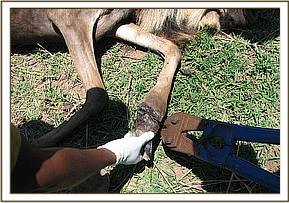

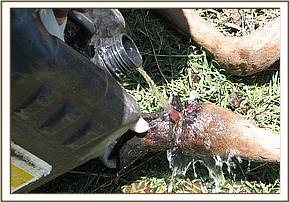

Treatment of a wounded female elephant near Oloololo gate Maasai Mara NR.
This was a case of an adult female elephant in a herd of six other elephants; it had a deep wound penetrating through the right thigh muscles. The wound was already infected, exuding some pus and with pieces of necrotic tissues falling off from the wound. It was suspected that the elephant was attacked with an arrow and later on an inflammation and infection set in.
Chemical immobilization and restrain
The elephant was darted from a vehicle using 17mgs of etorphine Hcl combined with 1500 i.u of hyaluronidase, the drug took effect after about 7 minutes and it became recumbent. The wound was examined and probed using a long tissue forceps and swabs.
Examination and treatment
The wound was then cleaned with a lot of water, exudates and necrotic tissues squeezed out. Then further cleaned using 10% hydrogen peroxide draining all the accumulated pus and tissue debris, and later treated with a tincture of iodine and oxytetracycline spray.

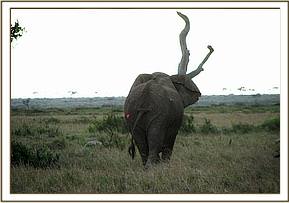
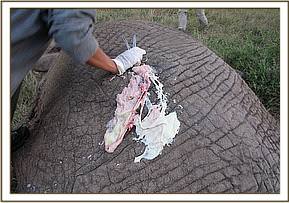
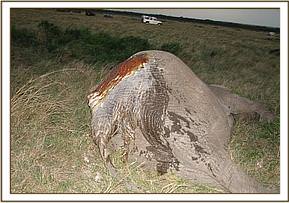

Revival of anaesthesia
After treatment, it was revived from anaesthesia using 36mgs of diprenorphine hydrochloride administered through the superficial ear-vein. The elephant was to be monitored closely by the Mara Triangle rangers who would report on its progress until it is fully recovered.
Prognosis
The elephant had a good prognosis after the treatment since the wound was not yet extensively infected and did not extend into the abdominal cavity. The animal was still active and in good body condition.
Conclusion
During the month of September, 2010, the Mara veterinary unit responded to all the reported veterinary cases within Maasai Mara ecosystem as indicated in the above report. The Kenya Wildlife Service appreciates the support of the David Sheldrick Wildlife Trust (DSWT) towards the provision of prompt veterinary services and conservation of wildlife in Maasai Mara ecosystem, Central Rift region and Ruma National park.
Report by: Dr. Domnic Mijele